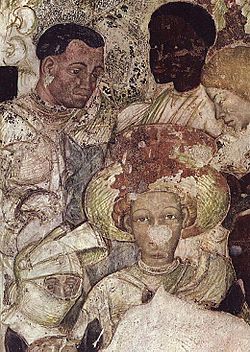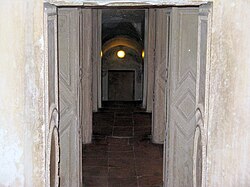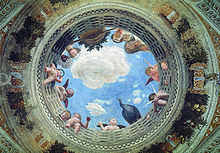Ducal Palace, Mantua



The Palazzo Ducale di Mantova ("Ducal Palace") is a group of buildings in Mantua, Lombardy, northern Italy, built between the 14th and the 17th century mainly by the noble family of Gonzaga as their royal residence in the capital of their Duchy. The buildings are connected by corridors and galleries and are enriched by inner courts and wide gardens. The complex includes some 500 rooms and occupies an area of c. 34,000 m2, which make it the sixth largest
The Gonzaga family lived in the palace from 1328 to 1707, when the dynasty died out. Subsequently, the buildings saw a sharp decline, which was halted in the 20th century with a continuing process of restoration and the designation of the area as museum. In 1998, a hidden room was discovered by Palace scholars, led by musicologist
Corte Vecchia
The entrance of the palace is from Piazza Sordello, onto which the most ancient buildings, the Palazzo del Capitano and the Magna Domus, open. They formed the original nucleus of the so-called Corte Vecchia.
The Palazzo del Capitano ("Captain's Palace") was built in the late 13th century by the Captain of the People Guido Buonacolsi (whose family ruled Mantua from 1271 to 1328). Initially built on two floors and separated from the Magna Domus (Latin: "Big House") by an alley, in the early 14th century it received a further floor and was united to the Magna Domus by a large façade with a portico. The additional floor consists of a huge hall (67x15 m), known as "Hall of the Weapon Room" of "Hall of Diet", as it housed the Diet of Mantua in 1459.
The monumental Scalone delle Duchesse ("Duchesses' Staircase"), built in the 17th century and renovated in 1779 by Paolo Pozzo, leads to the Room of the Morone, named after the 1494 canvas of the Veronese painter
Apartment of Isabella d'Este
In 1519,

Apartment of the Tapestries
During the
Castle of St. George
The Castle of St. George (Castello di San Giorgio) was built from 1395 and finished in 1406 under commission by

Camera degli Sposi
The Camera Picta (Latin: "Painted Chamber") or Camera degli Sposi (Italian: "Bridal Chamber") is the most famous room of the palace, known for its frescoes executed by Andrea Mantegna, from 1465 to 1475, as attested by slab celebrating the end of the works. The painter's decoration creates an illusionistic space, as if the chamber was a loggia with three openings facing country landscapes among arcades and curtains. The painted scenes portrays members of the Gonzaga family.
Domus Nova

The Domus Nova (Latin: "New House") was originally designed by Luca Fancelli in 1480–84. During the reign of Duke
The Galleria Nuova ("New Corridor") was constructed in 1778 by

Under his apartment in the Domus Nova, Vincenzo Gonzaga's son, Cardinal (later Duke)
Corte Nuova
The main feature of the Corte Nuova ("New Court") is the Sala di Manto, once the entrance to the "Apartment of Troy", which takes its name from the frescoes (1538–1539) by collaborators of

Palatine church of Santa Barbara

The church of Santa Barbara, which had the role of Palace chapel ("Basilica Palatina") for the Gonzagas, was built in 1562-1572 by Giovanni Battista Bertani, commissioned by Duke Guglielmo.[5] As a
The church has a central plan, with a square
The interior contains two lateral altars, surmounted by large canvas altarpieces by
Organ
In 1565 the church was provided with an organ in 1565 by Graziadio Antegnati, a member of a distinguished family of organ builders. The organ was restored in 1995.[7]
Gardens and courtyards

- Cortile della Cavallerizza, designed by Giovanni Battista Bertani, who in 1556 adapted the style of the buildings surrounding this courtyard to the Mannerist style of Giulio Romano characterizing the pre-existing palace, called "La Rustica", which also faced it. It was the place where the Gonzaga's horses were shown before being sold.
- Giardino dei Semplici ("Garden of Simples", i. e., medicinal herbs), also known as Giardino del Padiglione, built in 1603 by Zenobio Bocchi. It housed the flowers and the essences used by the members of the Gonzaga court to perfume their clothes.
- Hanging Garden, in the Refectory (late-16th century), located at 12 m of elevation. During the 18th century, during the Austrian rule, it received a Coffee House.
- Secret Garden, part of the apartment of Isabella d'Este in the Corte Vecchia, built 1522 by the Mantuan architect Gian Battista Covo.
- Cortile delle Otto Facce ("Courtyard of the Eight Faces"), also known as Cortile degli Orsi ("Courtyard of the Bears").
- Cortile del Frambus
- Cortile d'Onore or Ducal Garden
- Cortile di Santa Croce
- Cortile dei Cani
See also
- National Archaeological Museum of Mantua, museum located inside Ducal Palace

References
- ^ Municipality of Mantua. Palazzo Ducale.
- ^ Alberto Angela (March 12, 2019). St 2019 Episode of 12/03/2019. Wonders - The peninsula of treasures. Rai 1. Event occurs at 00:18:40. Retrieved March 14, 2019.
- ^ Howard Goodall, Big Bangs, 2000
- ^ "I cartoni di Raffaello e le altre serie di arazzi", Ducal Palace, Mantua, website
- ^ "Palatine Basilica of Santa Barbara Website (italian)". Archived from the original on 2008-07-05. Retrieved 2012-06-06.
- ^ Dixon, Graham. “Monteverdi's Vespers of 1610: 'Della Beata Vergine'?”. Early Music, vol. 15, no. 3, 1987, pp. 386–389. Accessed via JSTOR (subscription required).
- ^ "The Santa Barbara Organ". Archived from the original on 2019-04-19. Retrieved 2019-07-18.
